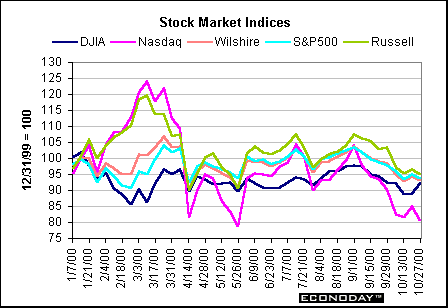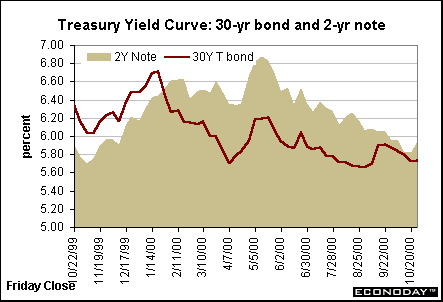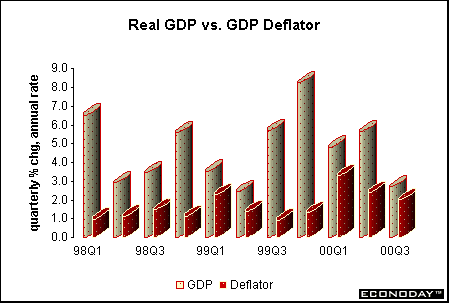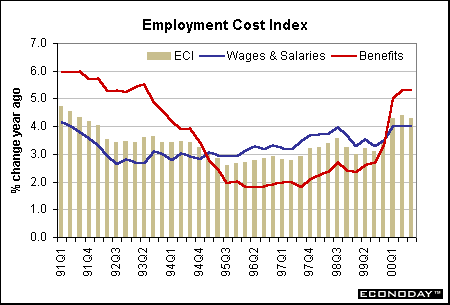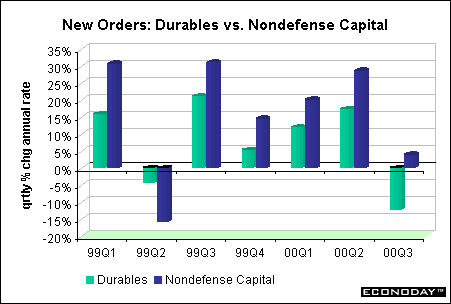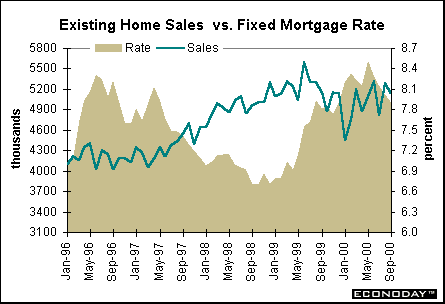| |||||||||||||||||||||||||||||||||||
| Previous Articles |
|
The yo-yo in the stock market may continue for another few weeks as market players vacillate between good and bad earnings reports. Each market sector seems to have had its share of good news/bad news. This isn't uncommon when shakeouts in the market try to find the bottom and gear stocks for a resurgence. In the meantime, economic data point to the very moderation that Fed officials have been expecting for a long while. Has it bottomed yet?
Treasuries fluctuate amid volatile equities
GDP slows to a crawl
Personal consumption expenditures actually accelerated during the quarter, rising at a 4.5 percent rate after increasing at a 3.1 percent rate in the April to June period. A resurgence in durable goods (motor vehicle sales, mainly) helped to propel the sector, but nondurable goods also posted a healthy gain for the quarter. In contrast, residential investment spending decreased at a 9.2 percent rate in the July to September period. Keep in mind that housing activity remains solid, but is down moderately from the first half of the year. This downward trend could continue through the end of the year and into early 2001. This would also hamper spending on consumer durables in coming months. Capital spending seems to have taken the biggest hit. While business fixed investment rose at a healthy 6.9 percent rate in the third quarter, it appears downright meager relative to the double-digit gains recorded in the first half of this year. Both equipment and structures grew more slowly. Inventory building grew at about the same pace as the second quarter and did not affect GDP growth. But the two-month pace of inventory building combined with softer final sales (2.7 percent in the third quarter after a 3.9 percent rate in the second quarter) could point to some production cuts in coming months. The foreign sector was a drag on growth with a widening net export deficit. However, exports jumped at a 16.2 percent rate in the third quarter while imports rose at a 13.8 percent rate. Keep in mind that these figures are most often revised - and by the largest magnitude of any GDP components - since the Commerce Department does not have complete data for another couple of months. The GDP deflator increased at a 2 percent rate in the third quarter, less than the gains posted in the first half of the year. This partly reflects softer gains in energy prices relative to earlier in the year. Also, prices of durable goods continue their sharp downward trend. The bottom-line on economic growth? Economic activity is moderating to a more sustainable pace - in line with what Fed officials would prefer to see in order to keep inflationary pressures at bay. While the drop in government expenditures probably overstated the decline in final demand in third quarter GDP, there is no question that growth has shifted to a lower gear. Inflationary pressures are not accelerating - indeed have moderated now that the worst of the energy price hike has been incorporated into the price measures. The GDP data will not lead Fed officials to change their tighter bias, but it should prevent them from raising rates at the November and December FOMC meetings. Compensation moderates quarterly, but still high yearly
The acceleration in the ECI is coming from the benefits portion. Wages and salaries have essentially risen at the same pace for the past three quarters. Benefit costs are accelerating more rapidly, however. Note the sharp upward trend in benefit costs in the chart above. Incidentally, the Bureau of Labor Statistics released information on a pilot survey regarding stock options in private industry. Until recently, many analysts have suggested that the ECI underestimates compensation costs because stock options were not included in this series. As it turns out, 1.7 percent of all private industry employees received stock options in 1999. That's not a very large number and should dispel the myth that this series is underestimating labor costs. The bottom-line on compensation? The employment cost index rose less-than-expected in the third quarter, and somewhat less than the first half of 2000. However, the yearly gain in the ECI is still faster than a year ago when the index was rising at less than a 3.5 percent rate. These figures should relieve the minds of Fed officials who were concerned that compensation costs would accelerate in the tight labor markets. Recent employment statistics suggest that the degree of labor market tightness might be alleviating. These figures won't cause Fed officials to change their bias, but it shouldn't lead them to raise rates either at the next FOMC meeting. Durable goods slow down
New orders for nondefense capital goods increased 2.6 percent in September after a 5.3 percent spurt in August, but follow a 12.2 percent plunge in July. All in all, this adds up to a very modest gain for the quarter. The third quarter GDP figures already showed a moderating pace of capital spending. These figures suggest that the moderation may continue into the fourth quarter as well. The bottom-line on durable goods? Durable goods rose modestly in August and September, but this didn't make up for the July plunge. As a result, new orders appear to have shifted down in the third quarter - which means that industrial production and capital spending are likely to moderate in the fourth quarter. These figures may reassure Fed officials that economic activity is slowing down. Odds & Ends
In September, the U.S. Treasury announced a budget surplus of more than $65 billion. This brought the fiscal year 2000 surplus to $237 billion, nearly twice the size of the 1999 fiscal year surplus of $124.3 billion. Federal government coffers benefited from a spurt in individual and corporate income tax payments, up 14.2 and 12.2 percent, respectively, from year ago levels. In the meantime, total outlays gained a modest 5 percent from a year ago. As the budget surplus widens, the Treasury will have smaller borrowing needs and fewer Treasury securities will be coming to market in the year ahead.
THE BOTTOM LINE Inflation news remains relatively favorable. Compensation costs have remained rather stable this past year. Thus far, the gains are slower than productivity growth and are not inflationary. Fed officials can only hope that this trend will continue. The GDP deflator moderated in the third quarter as the bulk of the negative news coming from the energy sector was already incorporated in the first half of the year. On the whole, the economic and inflation news should not change the minds of Federal Reserve officials in terms of shifting monetary policy at the next FOMC meeting in November. They are likely to keep the "heightened inflationary pressures" risk statement. The Fed will need a more decided slowdown in the pace of economic growth along with improved inflation figures before they remove this bias. But a rate hike is not in the cards at either the November or December FOMC meetings. Looking Ahead: Week of October 30 to November 3 Monday Tuesday The Chicago purchasing managers index is expected to edge down to 50 percent in October from a level of 51.4 in September. A level of 50 percent or above signifies a growing manufacturing sector. (Forecast range: 49.0 to 52.0) The consensus calls for a 0.8 percent gain in new home sales in September to a 900,000 unit rate. Sales remain at relatively high levels based on historical performance, but are down from their peak. (Forecast range: 850,000 to 925,000) Wednesday Construction spending is predicted to rise 0.5 percent in September, less than the 1.4 percent gain posted in August. This reflects a more modest pace for both residential and nonresidential structures. (Forecast range: -0.5 percent to 1.0 percent). The Beige Book coming from the twelve Federal Reserve district banks will be reported in the afternoon. Economists and market participants will look for signs of economic slowdown and moderation in wage increases. Also, they will look for a lower degree of labor market tightness. Thursday Economists are looking for a 3.0 percent rise in nonfarm productivity in the third quarter. This would be a decided slowdown from the 5.7 percent gain recorded in the second quarter. (Forecast range: 2.7 to 4.1 percent). At the same time, unit labor costs are predicted to rise at a 1.8 percent rate, compared with a 0.4 percent drop in the second quarter. (Forecast range: 0.8 to 2.4 percent) The consensus is looking for the index of leading indicators to remain unchanged in September after declining in each of the previous three months. This index points to slow growth in the economy, but no downturn. (Forecast range: -0.2 to +0.2 percent) Friday Factory orders are predicted to rise 1 percent in September, incorporating the 1.8 percent gain in durable goods. This would be smaller than last month's 2 percent gain. (Forecast range: 0.3 to 1.2 percent) |
||||||||||||||||||||||||||||||||||||||||||||||||||||||||||||||||||||||||||||||||||||||||||||||||||||||||||||||||||||||||||||||||||||||||||||||||||||||||||||||||||||||||||||



